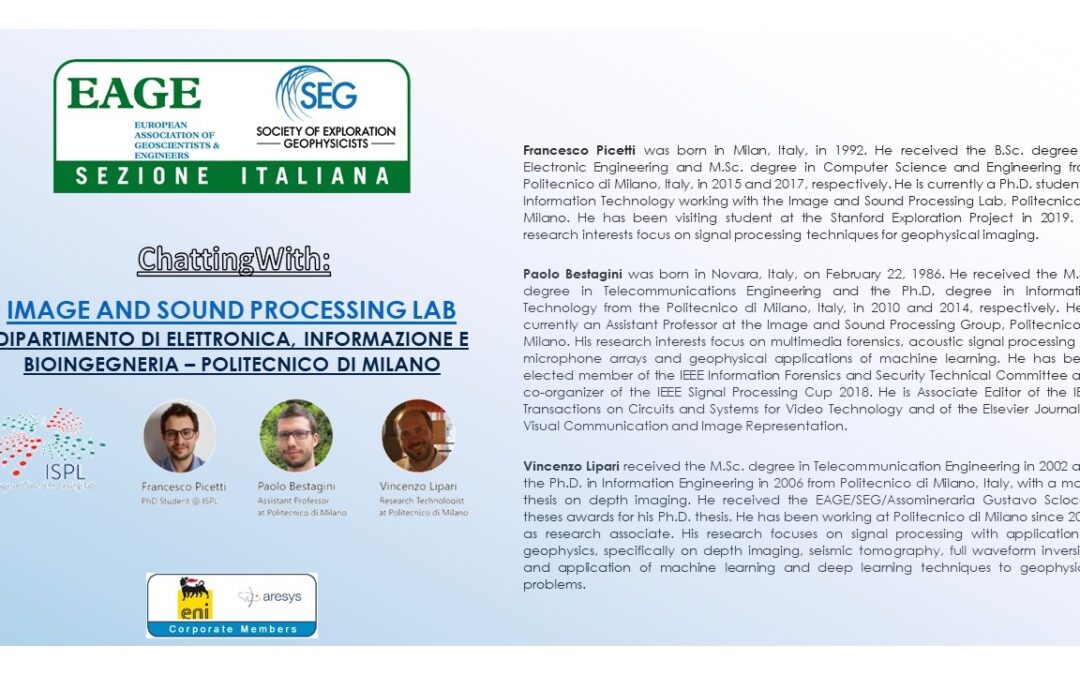My name is Vincenzo Lipari, and I always worked in the electronics, information and bioengineering department of the Politecnico di Milano. I’m currently a technologist responsible for the geophysical activities of the ISPL laboratory. ISPL belongs to the electronics, information and bioengineering department of the Politecnico di Milano. I graduated in Telecommunications Engineering in 2002. I have been involved in seismic data processing since my thesis. In particular, my thesis dealt with Kirchhoff migration. I continued my research during my PhD always in the research group of Professor Drufuca dealing with Kirchhoff migration in the angles depth domain. I remained in Prof. Drufuca’s team, following the undergraduate and PhD student programs and collaborating with Eni. During that period, I dealt with various problems, from the multiples prediction to the diffraction imaging, from anisotropy to the regularization of reflection tomography and lately, Reverse Time Migration and particularly Full Waveform inversion. In recent years, after the merger of Professor Drufuca’s old group within ISPL, I also become more and more interested in machine learning aspects, deep learning and their geophysical applications.
My name is Paolo Bestagini, and I am a researcher at the “Image and Sound Processing Group” (ISPL) at Department of Electronics, Information and Bioengineering (DEIB) of the Politecnico di Milano. From a professional point of view, I was born and grown up at the Politecnico. I graduated in Telecommunications Engineering in 2010, and in 2014 I got my PhD in Information Technology at the Politecnico di Milano. After my PhD, I started at DEIB, first as a Postdoc researcher, and now as a researcher. I started my career as a PhD student working on methods for locating acoustic sources through microphones array. Due to the ISPL group multidisciplinary nature and the new incoming research projects, I soon approached the world of audio, images and video forensic analysis which today is my main research topic. Considering my research tools, at the beginning I certainly used a lot of knowledge in the signal processing field. I gradually approached the world of machine learning. Thanks to Vincenzo, I also approached the world of geophysical data analysis, trying to apply machine learning tools.
I’m Francesco Picetti, PhD student in the ISPL group. I graduated with a thesis on the acoustic fields analysis with microphones arrays, for localization of sources and sound scenes manipulation. After my graduation, I started working with Paolo and Vincenzo on geophysical processing through deep learning techniques, from ground penetrating radar to seismic acquisitions and Reverse Time Migration. Last year I visited the Stanford Exploration Project, a group led by professors Biondo Biondi and Jon Claerbout. I currently collaborate with their students on a HPC cluster numerical optimization library.
You all work within the PoliMI Telecommunications Engineering Department … for what purposes was the ISPL group founded? How did it change in time?
PB: The DEIB is certainly a great reality within the Milan Polytechnic. It includes over 1000 professionals: about 200 professors, 50 researchers, 200 research fellows and over 350 doctoral students. Research activity is certainly very profitable in many areas ranging from information technology, electronics, telecommunications, automation and even bioengineering.
Every year, over 500 courses are developed by the DEIB. They are divided into different degrees: BSc, MSc and PhD, which undoubtedly attracts many students also from abroad. The ISPL is one of the many research groups of the DEIB. It was founded in 1993 with the aim to develop processing techniques of multimedia signals (audio, images and video). One of the characteristics of the group is the close collaboration amongst people who deal with the analysis of signals of a very different nature. Someone deals with space-time processing for audio signals (i.e. source localization, reconstruction of audio environments, etc.). Other students deal with image and video processing (i.e. forensic analysis, 3D reconstructions, monitoring of industrial processes, etc.). Other researchers are specialized in the field of music information retrieval (generation of music playlists, analysis and classification of songs, etc.). For some years, especially thanks to Vincenzo, we have also been dealing with the analysis of geophysical data. However, there are many other groups with great experience within the DEIB, which have been successfully dealing with various geophysical problems (i.e. seismic, radar, etc.) since many years.
VL: In the past, I would say that DEIB has a very long research history in geophysics, carried out by Prof. Rocca and Prof. Drufuca. As I mentioned, I collaborated for a long time with Prof. Drufuca as a coordinator. After Prof. Drufuca sudden death, we joined to the ISPL group. This has been an effective choice, because it allowed us to use synergistically our skills in image processing, machine learning, numerical signal processing and geophysics to tackle problems of seismic processing and classification of geophysical data.
Neural networks are nowadays used for the interpretation, processing and migration of seismic data: what are the main innovation and application areas?
VL: When the geophysics group joined the ISPL we immediately started thinking about possible synergies. Due to machine learning and deep learning large use in the multimedia field, it was clear to us from the very beginning (we were amongst the first researchers), how these techniques could be useful in geophysics. Then, we immediately started looking for potential applications. Successively, we read an article on The Leading Edge about the lithological facies prediction from well data and we saw that it was associated with a challenge promoted by the SEG. In my opinion, it was the turning point that gave both us visibility and a boost to machine learning in the geophysical community. We came in third in the challenge final score, however we introduced some solutions, thanks to our specific machine learning skills, Paolo’s above all, which were then adopted by all the teams that classified in the top positions. After this fantastic result, we understood how the synergic work between machine-learning experts and geophysical experts was the key of success. I would open a parenthesis: just in these days we joined another challenge on the same topic, achieving excellent results. Since then, we have actively tried to transfer the machine learning and deep learning skills to the pre-processing of seismic data, seismic imaging, inverse problems and finally seismic interpretation.
We often hear that Artificial Intelligence and neural networks have become somehow a new fashion, even when physically consistent approaches could be used, what is your opinion on that?
VL: There is no doubt that Artificial Intelligence and Neural Networks are a fashion. Like all fashions there is the risk of a bubble and it is probable that fashion could be followed by disenchantment. However, we need to sort out the reasons and the origin of this development. In my opinion, the huge expansion of this technology derived from an unprecedented growth of companies like Google and Facebook. Their prerogatives are to extract more and more information from data. This has given enormous impulses to collect data by any tool, especially via mobile devices, creating the so-called Big Data.
The same thing has encouraged the development and diffusion of:
- cheap and powerful computing resources;
- the development of very easy-to-use data processing frameworks and neural networks.
These improvements, combined with the successes achieved in computer vision have convinced companies in all sectors to make huge investments in:
- machine learning (perhaps with the idea that a machine can perform a task exactly the same way an expert would);
- deep learning;
- data science.
On the other hand, the ease of use has pushed many researchers to use pre-packaged solutions taken for example by computer vision without a true understanding of what it is done in the background.
In my opinion, there is too much: someone thinks that the so-called Artificial Intelligence is the tool for everything. In the future, most of the scientists could become skeptical. I believe that these things should be taken for what they are: very powerful and very useful tools, but there is still no full understanding about this subject yet.
Returning to the initial question with a bit of a context in relation to our experience:
– Surely I have seen very complicated uses of Convolutive Neural Networks proposed for very simple tasks in which a model based approach works well and at a much faster rate.
– There are many things that are interesting proof-of-concepts but yet very far from practical applications.
– It must be considered that geophysics is in a certain sense more complex than image processing for a variety of reasons. The enormous variety of situations and the consequent difficulty of generalizing, the absence in many cases of a “ground truth”, the dynamics of the involved data, the importance of a quantitative approach …
– So the challenge is to make the “physics based” approach coexist and work synergistically with machine learning in both directions. On the one hand, using the information extracted from the data as an aid to traditional approaches. I think for example about the possibility of extracting data from inverse problems regularizers that cannot be easily expressed in closed form, in the other direction trying to insert physical constraints in learning.
– Another area in which deep learning can certainly be useful is helping with a whole series of routine tasks. I am thinking, for example, of the interpretation or QC of data, deep learning could be useful in all of them for a first screening, freeing experts from repetitive tasks to devote themselves to the most difficult cases.
PB: I agree with what Vincenzo has just said. Surely today, deep learning is a fashion. It is applied in unjustifiable situations in which more classical methods still work very well and at low cost. On the other hand, it is still a mistake to have a very effective tool available and not use it. I am convinced that today it is important to understand for which applications learning tools can be interesting. Maybe today we produce little more than a proof-of-concept, but tomorrow the idea could be brought into production. Another point on which I agree with Vincenzo is that deep learning does not necessarily mean completely automated processes. I think it is useful to think about the possibility of automating a portion of a task, so that experienced operators can make better use of their time by focusing on the most difficult cases.
Part 1
Part 2




Recent Comments